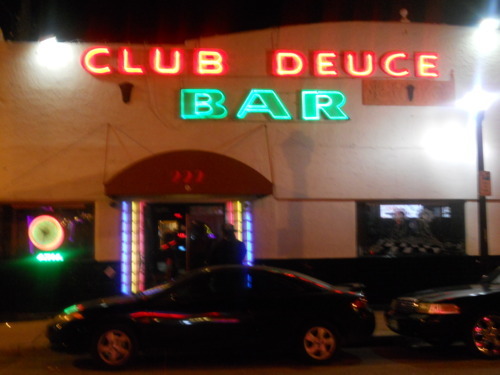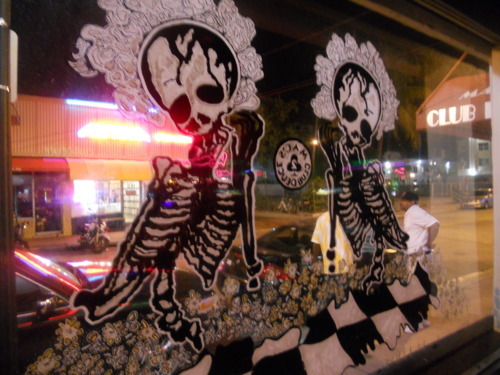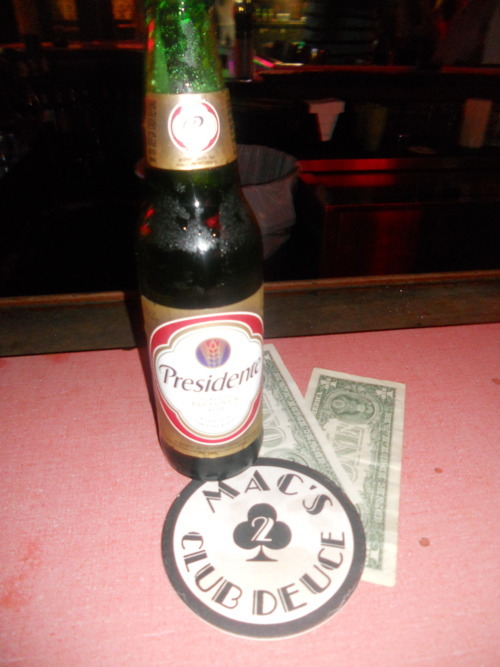One more at Club Deuce

April 30, 2012—-
Club Deuce doesn’t really belong on South Beach.
But then neither do I.
Club Deuce does not have an ocean front view and I look like the back end of a Greyhound heading to Key Largo.
I was at Club Deuce a couple weeks ago after a Cubs-Marlins game and stared out the front window painted with a pair of dancing skeletons.

A tiny all-night outdoor sandwich shop was across the street from Club Deuce. It was next door to a late night tattoo parlor. The Club Deuce is not in the rarefied air of the beautiful people at the Clevelander or the European edge of the News Cafe.
My friend John Hughes lived in South Beach in the 1980s when it was a truly dangerous no man’s land. John was an excellent writer for the now-defunct Miami News (1896-1988) and he took me to the Club Deuce for the first time.
John, who is now writing somewhere in Albania, brought me back to the Deuce several subsequent times. We chatted up cross dressers, laid odds on Mickey Rourke’s boxing career (John covered the 1991 fight) and we went to the Deuce for a beer and a shot in 1989 before I boarded my first midnight flight out of Miami to Havana, Cuba. John and I were big shooters. We had places to go.
Club Deuce hasn’t changed in 22 years.
Club Deuce opened in 1926, making it the oldest bar in South Beach. It’s now technically called Mac’s Club Deuce in homage to the guy that bought the bar in 1963.
The interior is basically dark, black, smoke and mirrors. The place is much more bar than anything else. An old bar snakes in and out of the room like a hefty bump and a grind. I’m guessing at least 50 people can sit along the zig-zag bar but I was not taking notes. It may be the mirrors and the large front window that force the customers to drink with their heads down. Club Deuce has a pool table which is always occupied and a computerized jukebox sits along the south wall.
The music from the jukebox is very loud. I was only at the Club Deuce for two bottles of Presidente and a shot of tequila, but I witnessed one dust up between a middle aged Hispanic gentleman and a younger, pale well dressed man who appeared to be gay, at least from my distance.
I could have been wrong.

There’s a lot of stray arrows at Club Deuce.
John Lee Hooker’s “Boom Boom” laid down the rhythms to their argument. Every good bar has a menacing soundtrack.
People still smoke heavily inside the Club Deuce. You don’t see many tourists at the Club Deuce. The Deuce is more of a locals community than a club, The middle aged female bartender with a faded tee shirt told me Anthony Bourdain is a Deuce regular during the Miami Food and Wine Festival. I once read in Miami New Times that Keith Richards drank at the Deuce while Kate Moss was denied entrance. The Club Deuce is open until 5 a.m.
A meaningless hockey game (especially in South Florida) was on one of the club’s two television sets during my visit. The score was tied at 2. There was a couple to my left who rode their bicycles to the bar. A stubble faced guy on my right was bumming cigs off the girl on his right. I did not see any Cub fans in Club Deuce.
So I began to catch up on my e-mail, which is odd because I usually don’t bring my cell phone into places like this. I am there to disconnect and the Club Deuce is a great place to get lost. It makes you want to drink. Hard. But I texted a South American country that suddenly didn’t seem so far away. I had been there when I had places to go. “2” has always been my lucky number and the two of us bounced that theme back and forth for a couple of minutes. Dreams and schemes came out of nowhere.
Suddenly there was magic everywhere.
The 1800 soon wore off and I walked out of the Club Deuce into a singular reality.


Leave a Response